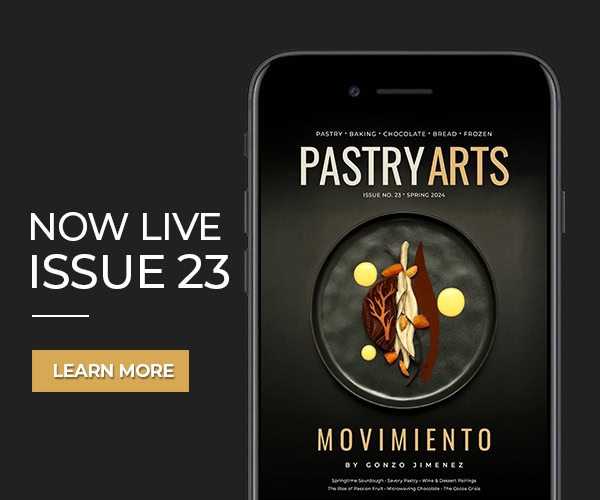(This article appeared in the Winter 2018 issue of Pastry Arts Magazine)
In this article, we are going to examine a new dessert featuring yellow bananas. These bananas are, of course, a versatile dessert ingredient. As pastry chefs we use bananas in many forms: raw, roasted, pureed, and ripened in breads and cakes.
There is something exceptional about bananas that tie us to memories of comfort. A ripe yellow sliced banana in cold milk and sprinkled with sugar is so basic, but has an instant trigger to childhood memories. That emotional attachment to the desserts we create as chefs can be lost when we ‘elevate’ dishes past where memory allows our diners to relate to our cuisine.
Let’s continue by looking at a few classic preparations of bananas. Many diners are familiar enough (or have made) the ‘Banana Pudding’ concoction of vanilla wafers layered with raw bananas and covered in vanilla pudding and whipped cream. Here we have the raw bananas served cold with creamy textures and vanilla flavor. We’ll add some raw bananas to our dessert and take note of the pudding as a complement to the bananas.
Another very popular dessert, Bananas Foster, features bananas that are sautéed with brown sugar and butter, and flambéed with dark rum. This is poured over vanilla ice cream. Here we have cooked bananas with some dark caramelized sugar flavors and, again, the presence of vanilla.
When we look at a typical Banana Split, we have raw bananas flanking three scoops of ice cream, topped with fruit, caramel, hot fudge and nuts, and topped with whipped cream. We see the common thread of temperature variance, raw and cooked items and bananas paired with cold and creamy elements.
The final type of banana dessert we are going to consider is banana bread or cake. This cake is typically best prepared with very ripe or ‘black’ bananas, which become sweeter as the starch changes into simple sugars. When made with these ripe bananas, the banana bread is rich in banana flavor. Our recipe is oil based, and contains brown sugar for caramel notes and plenty of vanilla.
Our research is done. Now it’s time to design an elaborate and expressive banana dessert that contains the emotional connections we’ve made. We’re going to start with a small banana bread cake ball and freeze that inside a banana mousse sphere. The outside is finished with milk chocolate spray. This is the center of our dessert and will be thawed for service and served chilled.
We will add raw bananas slices and caramelize them, and also add candied kumquats to bring a bit of acid to cut through the dessert. At tableside, we’ll pour hot caramel sauce over the banana mousse sphere. We have included raw bananas, banana bread, hot caramel sauce, cold mousse, and plenty of vanilla. Each of our choices retains the emotional connection to the classical desserts, but allows us to create a stunning restaurant dessert.
That initial step of exploring classical banana desserts and extracting the emotional connection and its relationship to taste is what’s important here. No matter how far away we get from familiar banana desserts, we’re going to take notes of the emotional, taste and memory aspects of classical banana desserts to anchor our elaborations for our new banana dessert. It is in this way we can express new dessert ideas and tell a new story about bananas without losing our diners. Now go ahead and try this same exercise with other dessert classics.






You must be logged in to post a comment.